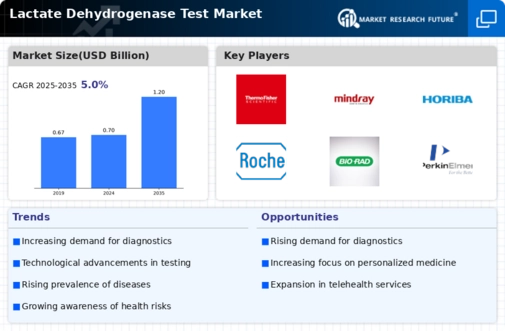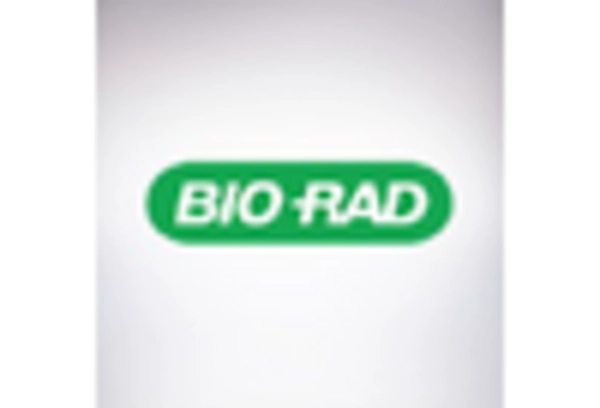Rising Incidence of Chronic Diseases
The Lactate Dehydrogenase Test Market is significantly influenced by the rising incidence of chronic diseases such as cancer, liver diseases, and cardiovascular disorders. Lactate dehydrogenase levels are often elevated in patients with these conditions, making the test a valuable tool for diagnosis and monitoring. As the prevalence of chronic diseases continues to rise, the demand for lactate dehydrogenase testing is expected to increase correspondingly. According to recent data, the incidence of chronic diseases is projected to rise by approximately 25% over the next decade, which could lead to a substantial increase in the utilization of lactate dehydrogenase tests. This trend underscores the importance of the Lactate Dehydrogenase Test Market in providing essential diagnostic information for managing chronic health conditions.
Expansion of Healthcare Infrastructure
The Lactate Dehydrogenase Test Market is poised for growth due to the expansion of healthcare infrastructure in various regions. As healthcare facilities increase in number and capacity, access to diagnostic testing, including lactate dehydrogenase tests, is likely to improve. This expansion is particularly evident in emerging markets, where investments in healthcare infrastructure are on the rise. Enhanced access to diagnostic services is expected to lead to higher testing rates, thereby driving demand within the Lactate Dehydrogenase Test Market. Furthermore, the establishment of new laboratories and diagnostic centers is anticipated to facilitate the availability of advanced testing technologies, further supporting market growth. Projections suggest that healthcare infrastructure investments could increase by 15% over the next five years, positively impacting the lactate dehydrogenase testing landscape.
Growing Awareness of Preventive Healthcare
The Lactate Dehydrogenase Test Market is benefiting from the growing awareness of preventive healthcare among the population. As individuals become more health-conscious, there is an increasing emphasis on early detection and prevention of diseases. Lactate dehydrogenase testing plays a crucial role in identifying potential health issues before they escalate into more serious conditions. This shift towards preventive healthcare is likely to drive demand for lactate dehydrogenase tests, as healthcare providers recommend routine screenings for at-risk populations. Market data indicates that preventive healthcare spending is expected to rise, potentially reaching 20% of total healthcare expenditures in the next few years. This trend is anticipated to bolster the Lactate Dehydrogenase Test Market, as more individuals seek proactive health management solutions.
Increasing Research and Development Activities
The Lactate Dehydrogenase Test Market is also being propelled by increasing research and development activities aimed at improving diagnostic methodologies. Ongoing studies are focused on enhancing the sensitivity and specificity of lactate dehydrogenase tests, which could lead to more accurate and reliable results. Additionally, research into the correlation between lactate dehydrogenase levels and various health conditions is expanding, potentially uncovering new applications for the test. This focus on R&D is likely to attract investments and foster innovation within the Lactate Dehydrogenase Test Market. As new findings emerge, the market may witness the introduction of novel testing platforms and methodologies, further driving growth. It is estimated that R&D spending in the diagnostics sector could increase by 10% annually, contributing to the evolution of lactate dehydrogenase testing.
Technological Advancements in Diagnostic Tools
The Lactate Dehydrogenase Test Market is experiencing a notable transformation due to rapid technological advancements in diagnostic tools. Innovations such as point-of-care testing and automated laboratory systems are enhancing the efficiency and accuracy of lactate dehydrogenase testing. These advancements facilitate quicker results, which are crucial for timely clinical decision-making. Furthermore, the integration of artificial intelligence in diagnostic processes is likely to improve the interpretation of test results, thereby increasing the reliability of lactate dehydrogenase tests. As a result, healthcare providers are increasingly adopting these advanced technologies, which is expected to drive growth in the Lactate Dehydrogenase Test Market. The market is projected to expand significantly, with estimates suggesting a compound annual growth rate of over 5% in the coming years.


















Leave a Comment